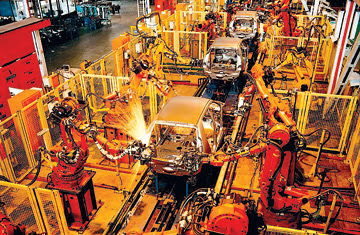French automaker Renault is keen on developing an affordable car for the Indian market that could be positioned above the Tata Nano in the sub-Rs 3-lakh space.
“Our history has been democratisation of technology and making cars affordable to a vast number of people. I cannot comment on the pricing of this product but it will be sandwiched between the ultra-low cost car planned with Bajaj Auto and other existing models,” Mr Jerome Stoll, Executive Vice-President, Sales and Marketing of Renault, told Business Line.
Growth drivers
Indications are that the car will be produced on a global platform, which will also cater to Brazil and other emerging economies. In that case, the business plan will be pretty much on the lines of what Toyota is planning with the Etios compact. Renault has already zeroed in on India and Brazil, along with Russia, as its future growth drivers beyond Europe.
Mr Stoll said Renault was convinced that there was a market for an affordable car in India. “If we want to be a major player both in India and other price-sensitive countries, this will be a priority,” he added. This explains why the company is pursuing a similar plan in Brazil where there is a sizable market for affordable cars. It will, however, be dearer than the one for India thanks to a host of levies.
Ultra-low cost car
Incidentally, the ULC with Bajaj is due to hit the roads in mid-2012 and is expected to start off with a base price tag of Rs 1.5 lakh and going upwards. Bajaj has been entrusted with the responsibility of developing the car where the focus will be on mileage of over 30 kilometres to a litre.
China, interestingly, does not figure in Renault's priority list though its global ally, Nissan, is working actively on growing its market share there. India's car market is still a fifth of China's but Renault believes that it still holds immense potential. “When we look at the rapid pace of growth in India, we are confident that there is room for us,” Mr Stoll said.
The company is categorical though that it will first focus on the large domestic market where five models, including two compacts, have been planned over the next two years. “We have to optimise the resources available here and are already sourcing engineering work, components and services,” he said.
Renault's India chapter did not exactly start on a promising note with the joint venture with Mahindra & Mahindra achieving little with the Logan in terms of numbers. “Brand awareness of Renault is still low and this could just end up being a big opportunity to redefine what we want to do now,” Mr Stoll said.
The company's logic in starting off with its new innings with the Fluence is more to do with positioning and conveying the Renault DNA. “It is a good way to showcase our technology in the upper end of the segment while meeting the customer's expectations,” he added.
“Our history has been democratisation of technology and making cars affordable to a vast number of people. I cannot comment on the pricing of this product but it will be sandwiched between the ultra-low cost car planned with Bajaj Auto and other existing models,” Mr Jerome Stoll, Executive Vice-President, Sales and Marketing of Renault, told Business Line.
Growth drivers
Indications are that the car will be produced on a global platform, which will also cater to Brazil and other emerging economies. In that case, the business plan will be pretty much on the lines of what Toyota is planning with the Etios compact. Renault has already zeroed in on India and Brazil, along with Russia, as its future growth drivers beyond Europe.
Mr Stoll said Renault was convinced that there was a market for an affordable car in India. “If we want to be a major player both in India and other price-sensitive countries, this will be a priority,” he added. This explains why the company is pursuing a similar plan in Brazil where there is a sizable market for affordable cars. It will, however, be dearer than the one for India thanks to a host of levies.
Ultra-low cost car
Incidentally, the ULC with Bajaj is due to hit the roads in mid-2012 and is expected to start off with a base price tag of Rs 1.5 lakh and going upwards. Bajaj has been entrusted with the responsibility of developing the car where the focus will be on mileage of over 30 kilometres to a litre.
China, interestingly, does not figure in Renault's priority list though its global ally, Nissan, is working actively on growing its market share there. India's car market is still a fifth of China's but Renault believes that it still holds immense potential. “When we look at the rapid pace of growth in India, we are confident that there is room for us,” Mr Stoll said.
The company is categorical though that it will first focus on the large domestic market where five models, including two compacts, have been planned over the next two years. “We have to optimise the resources available here and are already sourcing engineering work, components and services,” he said.
Renault's India chapter did not exactly start on a promising note with the joint venture with Mahindra & Mahindra achieving little with the Logan in terms of numbers. “Brand awareness of Renault is still low and this could just end up being a big opportunity to redefine what we want to do now,” Mr Stoll said.
The company's logic in starting off with its new innings with the Fluence is more to do with positioning and conveying the Renault DNA. “It is a good way to showcase our technology in the upper end of the segment while meeting the customer's expectations,” he added.

No comments:
Post a Comment